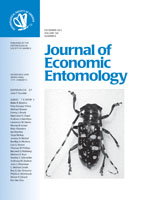The codling moth, Cydia pomonella (L.), and oriental fruit moth, Grapholita molesta (Busck), are two key pests of apple (Malus domestica Borkh.) in North Carolina. Growers extensively relied on organophosphate insecticides, primarily azinphosmethyl, for >40 yr to manage these pests. Because of organophosphate resistance development and regulatory actions, growers are transitioning to management programs that use new, reduced-risk, and OP-replacement insecticides. This study evaluated the toxicity of a diversity of replacement insecticides to eggs, larvae, and adults, as well as an assessment of their residual activity, to codling moth and oriental fruit moth. Laboratory-susceptible strains of both species were used for all bioassays. Fresh field-harvested apples were used as a media for assessing the ovicidal activity of insecticides. For larval studies, insecticides were topically applied to the surface of lima bean-based diet, onto which neonates were placed. Toxicity was based on two measures of mortality; 5-d mortality and development to adult stage. Ovicidal bioassays showed that oriental fruit moth eggs were generally more tolerant than codling moth eggs to insecticides, with novaluron, acetamiprid, and azinphoshmethyl having the highest levels of toxicity to eggs of both species. In contrast, codling moth larvae generally were more tolerant than oriental fruit moth to most insecticides. Methoxyfenozide and pyriproxyfen were the only insecticides with lower LC50 values against codling moth than oriental fruit moth neonates. Moreover, a number of insecticides, particularly the IGRs methoxyfenozide and novaluron, the anthranilic diamide chlorantriliprole, and the spinosyn spinetoram, provided equal or longer residual activity against codling moth compared with azinphosmethyl in field studies. Results are discussed in relation to their use in devising field use patterns of insecticides and for insecticide resistance monitoring programs.
How to translate text using browser tools
1 December 2011
Life Stage Toxicity and Residual Activity of Insecticides to Codling Moth and Oriental Fruit Moth (Lepidoptera: Tortricidae)
Leonardo C. Magalhaes,
James F. Walgenbach
ACCESS THE FULL ARTICLE
It is not available for individual sale.
This article is only available to subscribers.
It is not available for individual sale.
It is not available for individual sale.
baseline susceptibility
codling moth
oriental fruit moth
reduced-risk insecticides





